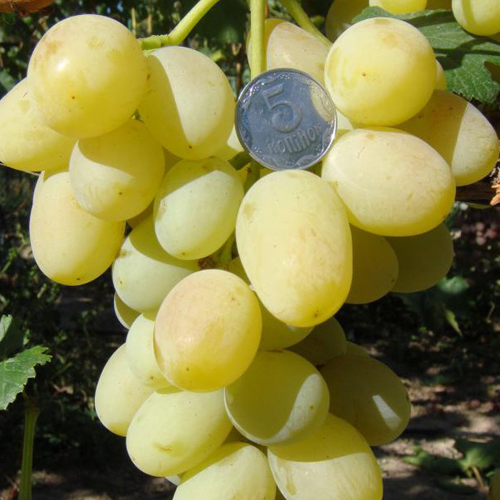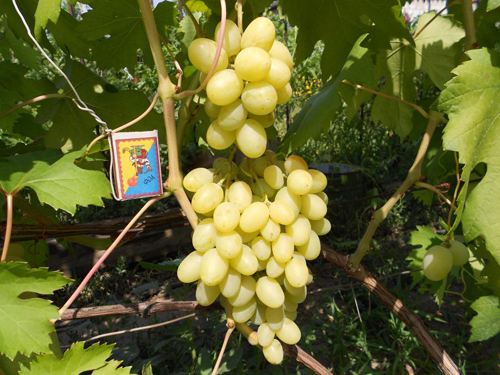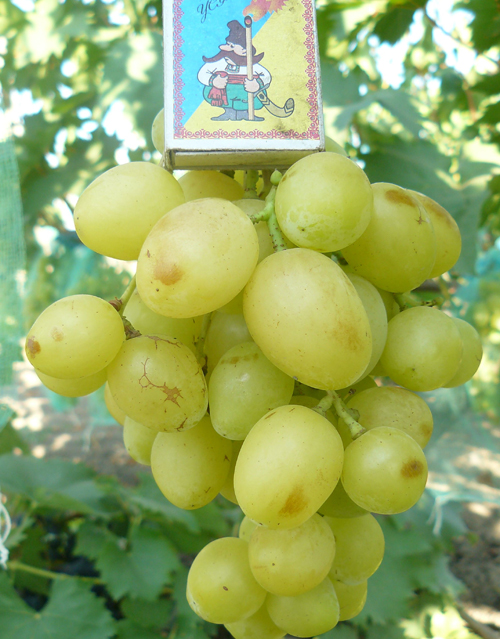Lily of the valley grape variety
Lily of the valley is one of the newest hybrid forms of table grapes, obtained by the national breeder Vitaliy Zagorulko from Ukraine. Like many of his colleagues, Vitaly Vladimirovich began to create new varieties, one might say, spontaneously, because his education was far from specialized - engineering. However, a big plus was the presence in his asset of many years of experience in amateur viticulture, due to which the new direction of activity did not start from a clean slate, but had a serious basis. The results of this work were not long in coming - many hybrids of the Zagorulko selection very quickly became widespread among the owners of summer cottages and farmers due to the excellent appearance of the bunches, the high taste of the berries and the decent indicators of the resistance of the bushes to unfavorable growing conditions. A large number of these new products have won medals and certificates at various industry exhibitions and competitions, and some have been awarded the high right to be included in the state registers of permitted plant varieties in Russia and Ukraine.

Lily of the valley cannot yet boast of passing the state variety testing, but due to its characteristics it is very promising, which is confirmed by numerous awards and the highest interest shown to it by winegrowers. It is appreciated for its large fruit size, beautiful color of berries, excellent gastronomic assessments and the “marketability” of the crop as a whole. At the same time, the resistance of this grape to disease and frost is average, it is quite far from complex-resistant varieties in this regard, but you cannot definitely call it pampered.
This variety is bred from crossing two very famous parents: Mascot, selection VNIIViV them. ME AND. Potapenko, as well as Radiant kishmish, the brainchild of the National Institute of Viticulture and Winemaking of Moldova. This pair has repeatedly demonstrated the ability to produce hybrid forms of amazing beauty, for which it is loved by so many enthusiastic breeders. Suffice it to note that the famous "troika" (Transformation, Anniversary of Novocherkassk and Victor) originated from the same parental forms. Its fantastic success will inspire the followers of Viktor Krainov to numerous experiments with this pair of varieties for many years to come, and the wonderful Lily of the Valley by Vitaly Zagorulko clearly demonstrates that the potential of such a combination is far from being exhausted.
Agrobiological characteristics of grapes
The plants are very vigorous, with strong annual growth and active accumulation of perennial wood. The crown of a young shoot is shiny, golden or bronze-green, without pubescence. The leaves are large, elongated, with a reticulate-wrinkled surface, five-lobed, strongly dissected, deep green in color. The denticles along the edge of the leaf are low, saw-shaped, with slightly convex edges and rounded apices. The upper lateral notches are deep, open, lyre-shaped or vaulted with a rounded bottom. The lower ones are of medium depth, V-shaped, or barely outlined. The petiole notch is open, vaulted, with a sharp bottom. Lily of the valley flowers are bisexual, well pollinated, but under unfavorable weather conditions, the inflorescences can crumble. No tendency to peel berries was noted. Annual shoots of grapes ripen normally, almost to the full length.

The bunches of the variety are rather large, conical or cylindro-conical, moderately loose, with an average weight of 500-700 grams, potential - up to one and a half kilograms. The combs are long, thick and strong, well developed, green in color, often with dark colored areas.The berries are oval-cylindrical, some have a pointed tip, dull yellow, greenish-white with a lack of light, impressive size - up to 36 mm in length, and up to 23 in diameter. The average weight of one grape is 9-14 grams, the largest - up to 16 grams. In the hand, they are sufficiently aligned in caliber and mass, are located freely, without being damaged or deformed against each other. The surface of the berries is covered with a light coating of a protective wax layer of medium density. The pulp is juicy-fleshy, tender, with a bright fresh, memorable taste and delicate aroma, in which you can find tones of nutmeg, lily of the valley and white acacia nectar. Obviously, the hybrid deserves its name for its unique bouquet of shades in the aroma of berries. The ratio of acid and sugar in juice is balanced, the content of glucose and fructose is about 18-19 grams / 100 ml, acids - 5-7 grams / liter. The skin is not thick, but quite strong, chewing it while eating is not difficult. Seeds, as a rule, are two or three, they are easily separated from the pulp and do not negatively affect the grape tasting ratings.
The crop is intended for use mainly fresh, but at the same time, juices, compotes and preserves from this variety are very tasty and aromatic. The bunches on the market literally fascinate customers with the attractiveness of large juicy berries of an appetizing sunny color. The highly marketable look is one of the main advantages of Lily of the Valley, along with its amazing taste and aroma. It is these qualities that determine his success among the already large army of his fans. It is also impossible not to note the high transportability of grapes and its suitability for long-term storage.
Ripening occurs in the medium term. The growing season from bud break to the onset of removable ripeness is 125-135 days, and in the south our hero is gaining his condition by the end of August, beginning of September. The sum of active temperatures required for this is 2700-2800 ° C, which makes it possible to cultivate the variety somewhat north of the zones of traditional viticulture, but, of course, not to the extent that early and ultra-early hybrid forms allow it. Lily of the valley's frost resistance is not the highest (-21 ° C), which requires at least a light cover almost everywhere.

Productivity is one of the strengths of this hybrid. On each fruitful shoot, an average of 1.1-1.5 bunches are laid, which, taking into account their large-fruitedness, form a significant yield on the bushes, and are quite capable of overloading the plant. The average yield is quite stable, and when taking measures to prevent shedding of the ovary, up to 20 kilograms of stunningly fragrant and tasty bunches can be harvested from an adult bush. A ripe crop for a significant period of time can be stored on the bushes without losing its presentation. Berries, thanks to the dense skin, are not afraid of wasps and other pests. In addition, they are quite resistant to cracking and decay, even in relatively humid seasons during the ripening period. The only, but very significant drawback of a long stay on the bushes is the tendency to liquefy the pulp and a slight decrease in the tasting ratings of fresh grapes for this reason.
Agrotechnical features
Lily of the valley demonstrates a high degree of plasticity and adaptability to a wide variety of growing conditions, with the exception of those where the crop does not physically have time to ripen due to lack of heat and a short growing season. The variety grows well and bears fruit on soils of various textures, levels of fertility and moisture supply. The cuttings root well, but their reproduction is possible only in regions not infected with phylloxera due to the lack of information about the resistance of Lily of the valley to this malicious soil pest. In the zone of continuous phylloxera infestation, planting of a vineyard should be carried out only with seedlings grafted onto rootstocks resistant to the pest.
At the same time, regardless of the composition of the soil and the method of propagation, grapes do not change their outstanding characteristics of the harvest, and, first of all, they do not lose their delicious multifaceted aroma. However, as is often the case with varieties that are magnificent in appearance, taste and aroma, their economic qualities are by no means so high, in connection with which these varieties require increased attention of the grower and scrupulous implementation of the necessary agricultural practices. This pattern fully applies to Lily of the Valley.
In the first years after planting, the bushes must be provided with opportunities for rapid growth, as well as begin to form the plant according to the chosen scheme. Development can be accelerated by creating a favorable agricultural background for grapes, by regular watering and feeding with moderate doses of mineral fertilizers. Under optimal conditions, a vigorous variety from the very first season will give a significant increase, and in its own-rooted culture it will please the grower with the first bunches already in the second year. Grafted seedlings, as a rule, lag behind in development by an average of a year.
It is recommended to form not very frost-resistant Lily of the Valley bushes according to a covering, stamp-free scheme. For this, perennial parts of plants are placed not high from the ground in order to be able to easily remove them from the trellis and insulate them in the fall. Convenient for application, and the most often used are such covering formations as fan-shaped multi-arm and oblique (inclined) cordon. Shelter of grapes is done with earth or organic heat-insulating materials (straw, shavings, spruce branches, reeds), with obligatory surface waterproofing (film, roofing material, wooden boards). However, in addition to the traditional scheme of warming the vine, you can try to use light film tunnel shelters. Under them, according to the author of the variety, the bushes are not afraid of frosts even down to -30 ° C.
Well, if you are lucky to have a plot in a subtropical climate, where there is no risk of lowering winter temperatures below −20 ... −21 ° С, then there you can easily grow Lily of the Valley on a high stem, giving the plants the opportunity to accumulate significant volumes of wood. Thus, you will help them create a large supply of plastic substances necessary for the formation of the very bountiful harvests of which these grapes are potentially capable.
The fight against fungal diseases must be carried out quite carefully due to the average resistance of the variety to them. The most harmful of them - mildew and oidium - are affected by plants by 3.5 points, which requires 2-3 mandatory chemical treatments against these pathogens during the growing season. First of all, spraying must be carried out in the most dangerous period for the vineyard - before and after flowering, after which it is necessary to carefully monitor the plantings and immediately respond to the appearance of the first signs of any disease. You need to be especially alert after rains, when the high humidity of the air creates ideal conditions for the reproduction of pathogens. At the same time, do not forget about the waiting time, and do not process the grapes with chemicals shortly before harvesting. No beauty of the bunches is worth the health undermined by the improper use of chemical plant protection products.
The load of fruiting Lily of the Valley bushes should be carried out in moderation, while maintaining 35-45 eyes per bush during spring pruning. The fruit arrows are shortened by an average of 6-8 buds, because the lower ones may be less fertile. When performing green operations, excess shoots are removed, primarily weak, sterile, etc. "Doubles" and "tees". Thinning of the bunches is also necessary, but it is not worth doing it before flowering due to the tendency of the variety to shedding the buds.Only after the ovary appears on the plants, the smallest and most loose brushes can be removed, leaving one, the strongest, on a fruitful shoot. To prevent shedding, it will not be superfluous to pinch the shoots before flowering, as well as apply specialized preparations, for example, FHF or Da-6.
During the ripening period of grapes, it is recommended to clarify the bunches in order to improve the color of the berries and additionally protect the crop from fungal diseases due to better ventilation of the fruit zone. Harvesting, despite its ability to preserve for a long time on the bush, it is preferable to carry out immediately after ripening in order to prevent a decrease in its taste. It is better to store already collected clusters of Lily of the Valley by hanging them on a wire in a cold, dry room, or spreading them in one layer on a layer of straw or sawdust.








